Arthur Charles Cole, 1821 - 1900
and
Martin James Cole, 1847 - 1928
by Brian Stevenson
last updated November, 2023
Arthur Cole began his career as a professional microscope slide-maker during the mid-1860s, while living in Liverpool, England. By the mid-1870s, his business had grown to the extent that he recruited his eldest son, Martin, away from the merchant navy to lend his hands. Martin’s handwriting is often seen on slides that bear A.C. Cole’s label. In 1877, Arthur, Martin, and family moved to London. The father and son business was dissolved in 1880, with each continuing his own slide-making business.
Both men made very high quality microscope slides, of a wide variety of subjects. Arthur won a medal at the 1867 Paris Exposition for his mounts, which he recounted on his slide labels. He also published several series of books with accompanying slides. Martin co-authored a widely-read book on microscope slide-making, Modern Microscopy, which was reprinted well into the twentieth century.
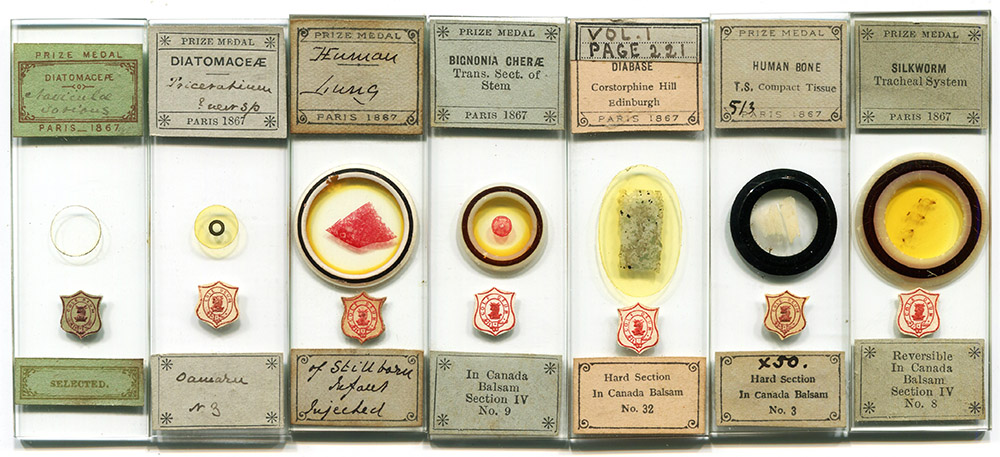
Figure 1.
Microscope slides by Arthur C. Cole, ca. 1867-1900. He affixed a shield with red printing, with a bull’s head and the motto “Cole Deum” (“Worship God”, although a pun of the mounter’s surname was undoubtedly intended). His labels also highlighted Cole’s medal at the 1867 Paris Exposition.
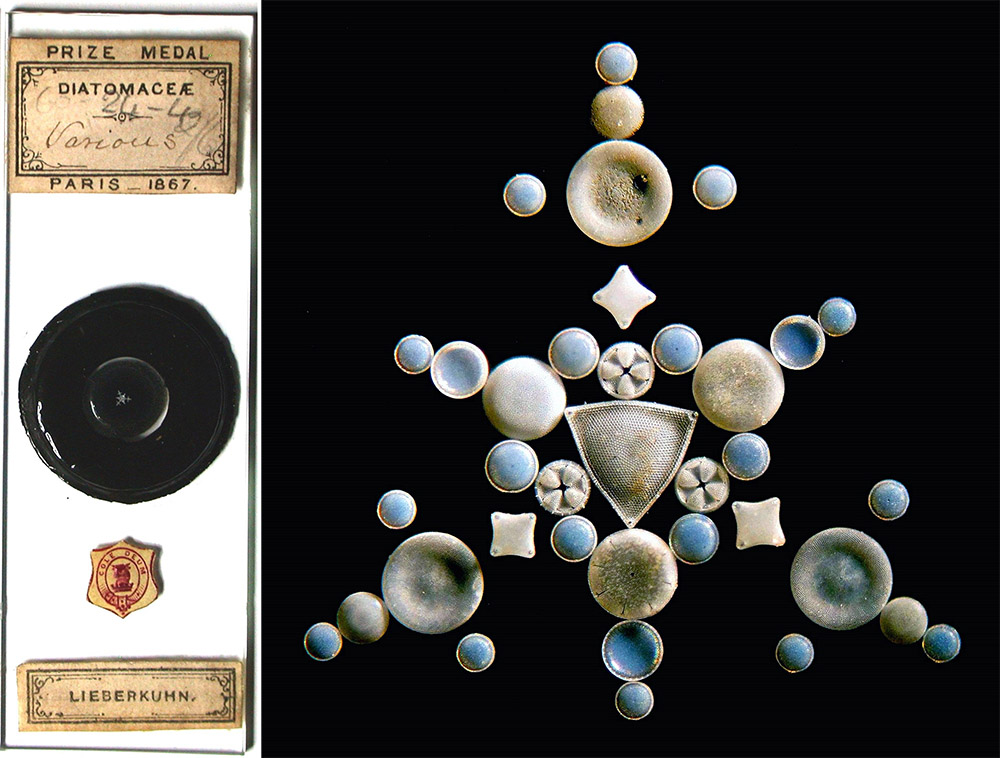
Figure 2.
Arthur Cole was an excellent preparer of artistically arranged diatoms. Courtesy of Howard Lynk.
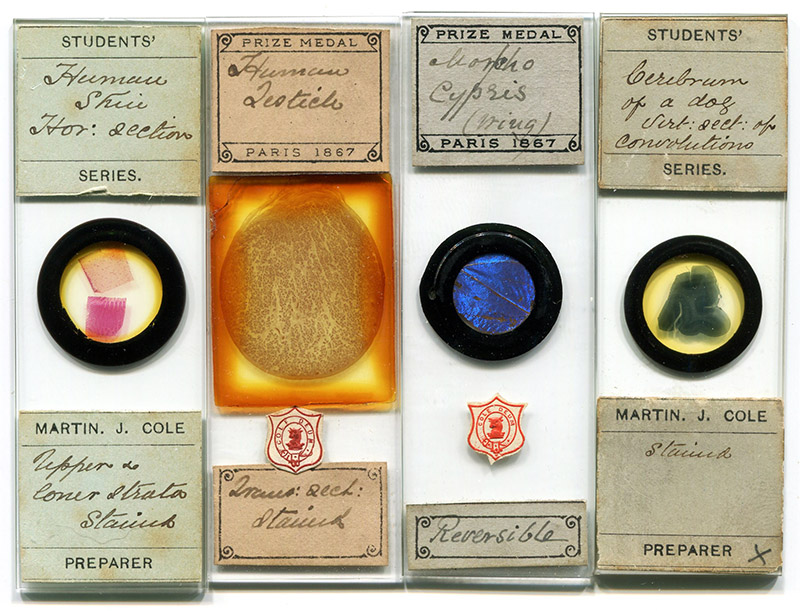
Figure 3.
Microscope slides that were prepared by Martin Cole, either under his own name or in collaboration with his father, Arthur. Martin’s handwriting is frequently seen on slides labeled “Cole Deum”, which was also the symbol of A.C. Cole & Son.
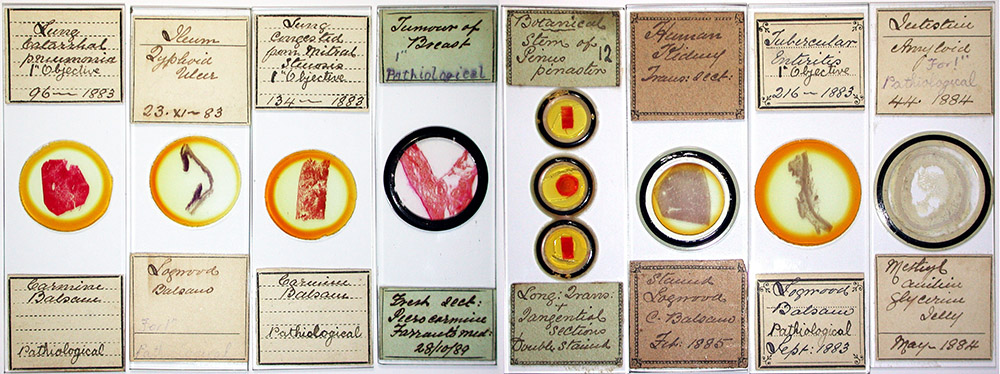
Figure 4.
Microscope slides with Martin Cole’s handwriting but without attribution to him. Noting that many are dated from the early 1880s, that may been produced before Martin had a formal distribution system. Images courtesy of Howard Lynk.
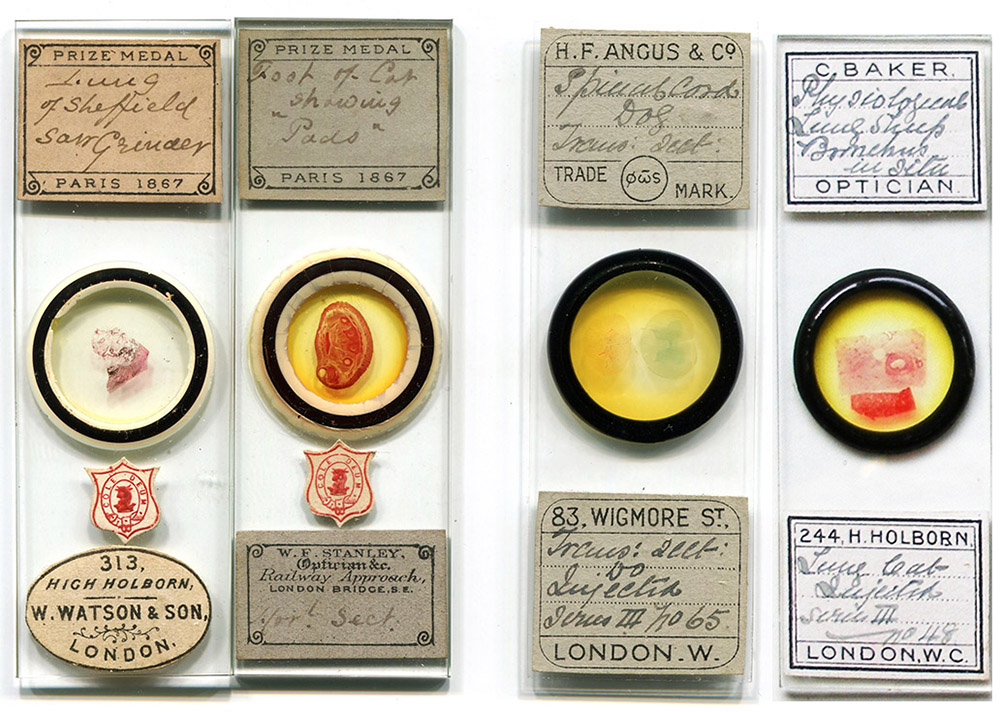
Figure 5.
Microscope slides by Arthur Cole that were retailed by W. Watson & Son and William F. Stanley (left), and by Martin Cole for H.F. Angus and Charles Baker (right). In 1879, Arthur Cole exhibited “sections of lung of a Sheffield saw-grinder who died from the effects of his work” to the Royal Microscopical Society.
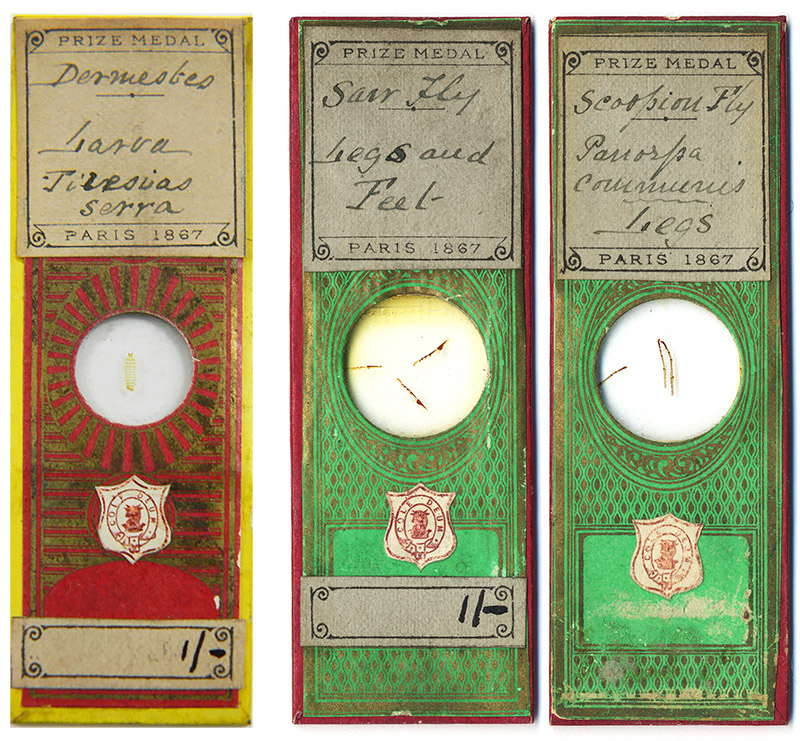
Figure 6.
Cole evidently re-sold slides that were produced by other makers. Shown here are (left) a slide by Edmund Wheeler (noting that Cole obscured Wheeler’s monograms with his labels) and (right) two slides by an unknown profession slide-maker who is known to collectors as “Green Papers”.
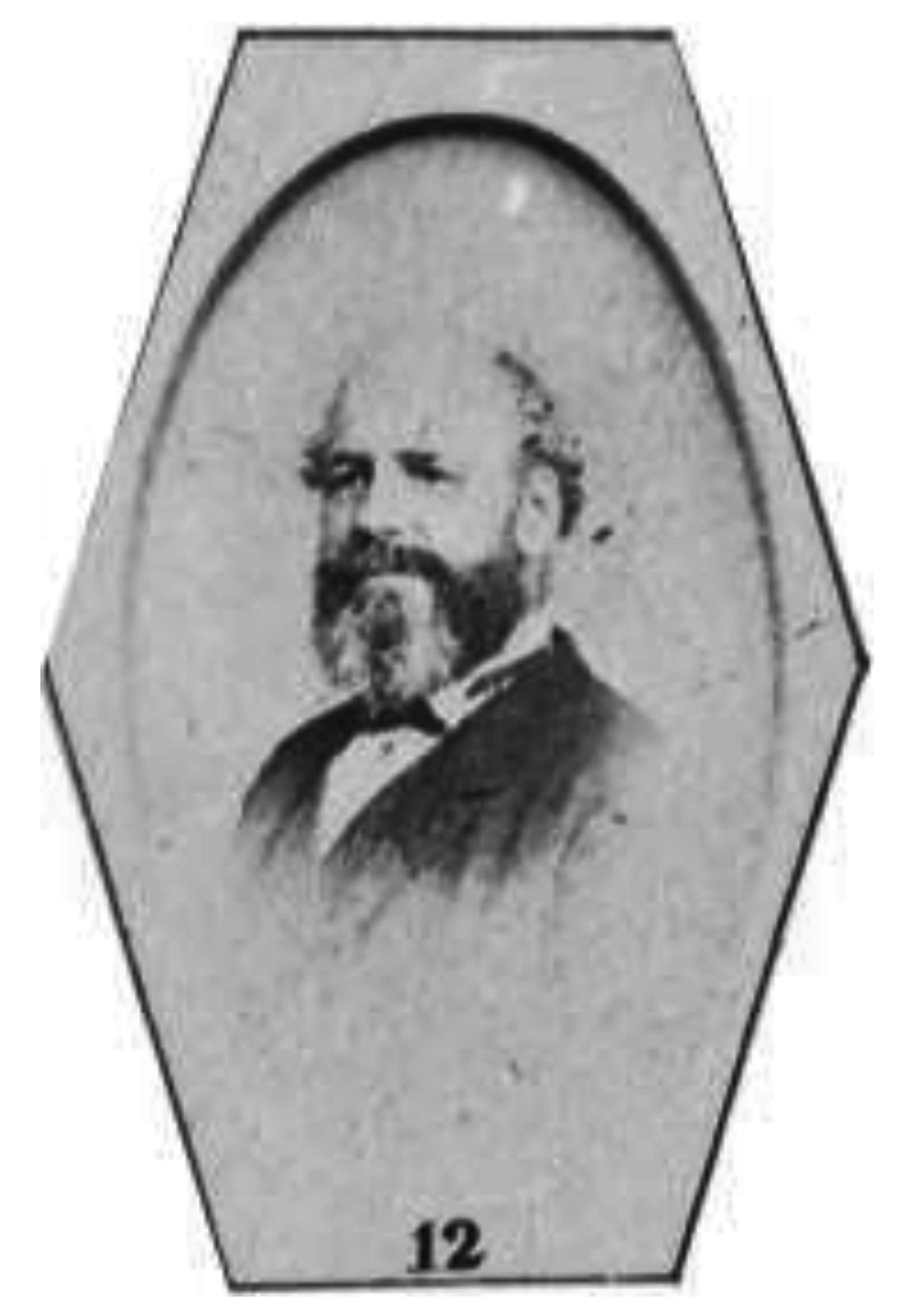
Figure 7.
Arthur C. Cole, ca.1874. In that year, he and other members of the Postal Microscopical Society were asked to provide their photographs, which were then arranged into a collage, then distributed to the members as a means to “introduce” them to each other.
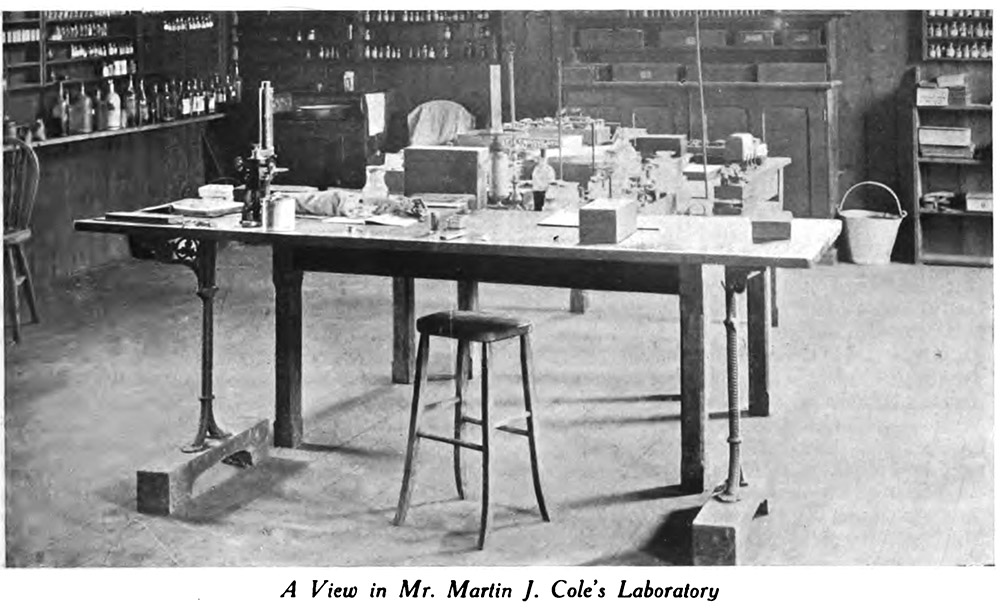
Figure 8.
Martin Cole’s slide-making laboratory, ca. 1911. This photograph was included in a 1911 magazine article on microscopy, which appeared in “The Country Home”. Author Amy Astbury’s described Cole’s lab, “Round the walls may be seen narrow shelves filled with small bottles containing every manner of material apparently, in readiness for the multifarious needs of students for whom the microscopist caters. One cannot help being struck with the heterogeneousness of the collection. One bottle is labelled ‘Pig's Liver’, another ‘Tail of Mouse’, another ‘Tongue of Dog’, another ‘Muscle’, another ‘Spores of Mallow’, and so on. There is no end to the diversity of the contents of those small bottles.”
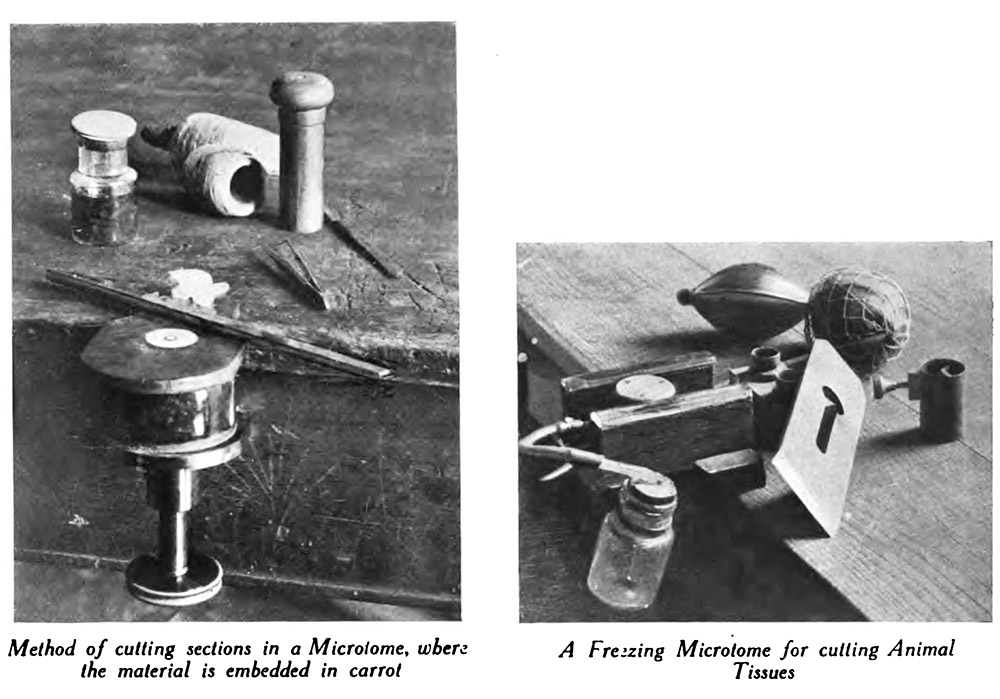
Figure 9.
Two of Martin Cole’s microtomes, from Amy Astbury’s 1911 article on microscopy. She wrote, “ the microtome, an instrument used for cutting very thin sections, will probably not find a place at first among the beginner's apparatus. He will possibly content himself with embedding his specimens in elder pith or carrot and cutting slices with a sharp razor; but if he undertakes serious work, he will do well to invest in a microtome, a quite simple instrument which screws firmly on to the table, and by the turning of a fine screw allows of any number of sections being cut one after the other. Some specimens cannot be successfully embedded in carrot … and then the microtome becomes a necessity, for the tissues to be cut must be placed in the ‘well’ of the apparatus, covered with melted paraffin, and cut when cold. The cutting of animal tissues is more difficult than that of slicing plants, and often it becomes necessary to use what is known as a freezing microtome, which effects its object by means of an ether spray.”
Arthur Charles Cole was born on October 27, 1821, in Little East Cheap, London. He was the first child of John James and Elizabeth (nee Barraud) Cole. Father John worked as a “dry salter”, that is, a dealer in various chemical products such as glue, varnish, dyes, and salt, as well as preserved foods such as pickles or dried meats.
A younger brother, Martin James Cole, was born in April, 1824. He died in 1840. Arthur named his first child after his dead brother.
Arthur Cole married Emily Shute on October 8, 1845. Their first child, Martin James Cole, was born on October 30, 1847, in Camberwell, Surrey. Martin’s baptism record listed Arthur as being a “gentleman”, as did also the baptism of record of the next child, Florence. A national census was taken in the spring of 1851, and actual occupations were recorded. Arthur was listed as “professor of music”. The title “professor” indicated teacher, not necessarily in association with a college or other formal school. Arthur Cole had a business of teaching, writing, and performing music - an advertisement for one of his pieces is shown in Figure 10.
1861: Bankruptcy, and move to Liverpool. In February, 1861, Arthur Cole’s business as “teacher of music and organist” was declared insolvent.
Following his bankruptcy, Arthur moved to Liverpool. When his father died in 1865, Arthur was listed in the probate of the will as being a “book-keeper”. Brian Bracegirdle’s Microscopical Mounts and Mounters reports that Arthur also resumed his teaching of music while in Liverpool.
Circa 1867: Slide-making business begins. It is not clear when or how Arthur Cole decided to become a professional preparer of microscope slides. The earliest record that I found of that business is his display of “microscopic objects” in the 1867 Paris Universal Exhibition. These were apparently of good quality, as Cole was awarded a medal for his slides.
In 1868, the South Kensington Museum exhibited items from the Paris Exposition, including a “Collection of microscopic slides. Lent by Mr. Arthur C. Cole, Liverpool”.
During this time, son Martin Cole had gone to sea. In April, 1868, he qualified as a Second Officer in the Merchant Marine (Figure 11). He served on the ocean liner Delta when it passed through the Suez Canal on its opening day in 1869.
As is evident from the abundance of such slides, Arthur Cole took a fancy to mounting and studying diatoms. Undoubtedly as an advertisement for his business, Arthur donated “12 slides of diatoms” to the Quekett Microscopical Club on October 28, 1870. At the March 3, 1871 meeting of the Microscopical Society of Liverpool, “Mr. A.C. Cole exhibited a new diatom which he had found in the Nottingham (Maryland) earth, and mounted with his usual perfection. The diatom is not only new as a species, but in all probability is entirely unknown, certainly unnamed, generically”.
In 1873, Arthur Cole was advertised to exchange his arranged diatom slides for insect specimens (Figure 12). This was a route used by many other professional slide-makers to acquire new and exotic specimens.
Arthur’s slide-making business became a success. He lured Martin away from the sea, and formed a partnership as professional mounters of microscope slides. One particular topic that they expanded into was preparations of human and other animal tissues (Figure 13). Authorities were very enthusiastic about Arthur and Martin’s slides:
In 1875, The Lancet wrote, “We have received some specimens of histological preparations (normal and morbid), prepared by Arthur C. Cole and Son, of Everton, Liverpool. They are certainly admirable sections, and are beautifully mounted. To the teacher in search of typical specimens for the purposes of demonstration, such preparations as these must be invaluable. From the list of preparations also forwarded to us, we find many objects included which are not easily obtained, and the possession of which is essential to the accurate study of histology. The preparations are divided into three series of twenty-four specimens each: the one including injected specimens, the other normal, and the third pathological structures.”
That same year, The British Medical Journal wrote, “We have just had an opportunity of inspecting a series of microscopic slides prepared by Arthur C. Cole and Son of Liverpool. These slides illustrated both healthy and morbid tissues, and the sections brought out well the different structures, and were chosen from good specimens. As to the mounting, it was all that could be desired, and the sections, in size and amount of surface, exceed anything we have hitherto seen. The staining is done by a process peculiar to Messrs. Cole, and is far superior to any in use elsewhere. Taken altogether, they are the most perfect and beautiful things of the kind ever offered for public sale. This is not only our own opinion but that of some of the most expert microscopists of the day, who have testified to the excellence of these slides. For teachers wishing illustrations for their class-teaching, they will be found very acceptable; while to students commencing their histological researches, they will be invaluable, not only for their demonstrating power, but as models to be aimed at as the students themselves become experts in the art.”
1877: Return to London. Advertisements show that the Coles were in Liverpool until at least May, 1877, but had moved to London by December of that year (Figures 14 and 15). The move was likely due to their burgeoning slide-making business. London was a larger market that Liverpool, especially for the histological specimens that would have been high demand at the London area medical schools.
At the 1878 Paris Exhibition, they exhibited “Pathological preparations from the human subject, both doubly and singly stained. Physiological preparations from man and the lower animals, both injected and stained. Diatomaceae and insect preparations.”
Arthur Cole was elected as a Fellow of the Royal Microscopical Society in 1879.
On May 14, 1879, Arthur Cole exhibited “2 sections of lung of a Sheffield saw-grinder who died from the effects of his work, the lung being the typical specimen on which the late Dr. J.C. Hall founded his successful agitation for improved workshops” to the Royal Microscopical Society (see Figure 5).
In 1880, Arthur Cole was elected as an Honorary Member of the Microscopical Society of Liverpool. He maintained a relationship with his old club after moving to London. He donated twelve microscope slides in 1881.
William H. Shrubsole (1837-1927), a grocer, pharmacist, and amateur geologist who lived near the mouth of the Thames River, in Sheerness-on-Sea, discovered that a layer of local clay was particularly rich in diatom frustules that had become covered with mineral deposits. A contemporary wrote, “These diatoms are found forming a shallow layer throughout the London basin, and have been traced over about a hundred miles, the layer appearing continuous throughout the London clay, although very thin in comparison to the thickness of the entire formation. The siliceous skeletons of the diatoms are entirely coated over with ‘iron pyrites’, or sulphide of iron, giving them a brilliant gold or silver lustre. This coat can be dissolved off them by the action of weak acids, leaving the siliceous skeletons quite clean, and with their characteristic markings intact. It is remarkable that all the species of these diatoms belong to forms having a circular or triangular outline, the common spindle-shaped and rod-like forms being conspicuous by their absence.”
In the spring of 1880, Shrubsole arranged with Arthur and Martin Cole for them to produce arrangements of his mineralized diatoms on microscope slides (Figure 16). These novelties were sold by Cole for several years onward.
Shrubsole warned, in early 1880, that, “I regret to find that there are some beautifully mounted slides in circulation in London that have been sold, and are labelled as diatoms from the London clay, which are not what they purport to be. To prevent further disappointment to microscopists, will you allow me to say that arrangements have been made for slides of the London clay diatoms to be procurable shortly at any of the usual places? Due notice will be given by advertisement in this paper, when and by whom slides can be supplied to the trade.” (Figure 17).
1880: End of the Cole partnership. Arthur and Martin formally dissolved their partnership in late 1880: "Notice is hereby given that the Partnership heretofore subsisting between the undersigned, Arthur Charles Cole and Martin James Cole, carrying on the business of Microscopists, at 53, Oxford-gardens, Notting Hill, in the county of Middlesex, has this day been dissolved by mutual consent. The business will in future be carried on by the said Arthur Charles Cole, who will pay all debts owing by, and receive all moneys due to the said late firm. Dated this 14th day of December, 1880."
The end of the partnership was evidently cordial, and may have occurred to permit Martin to explore other career options. Martin still lived with his father, mother, and three siblings at the time of the March, 1881, national census. In 1884, when Arthur managed a microscope booklet / slide series, he stated that the series included slides that “were made by my son, Mr. Martin J. Cole (Instructor in Practical Microscopy at the Birkbeck Institution), and myself”.
The 1881 census provides additional insights on the Cole business: Arthur’s wife, Emily, and the three unmarried daughters who lived with them were all described as “microscopist assistants”. As with many other such cottage industries, the whole family helped. The daughters were aged 25 to 34, and would thus have had substantial experience with all aspects of producing slides. It is possible that the handwriting on some A.C. Cole slides is that of Emily or the daughters.
A.C. Cole joined the Postal Microscopical Society in 1881 (Figure 6). He resigned in 1889.
In May, 1882, Arthur Cole initiated a subscription series, Studies in Microscopical Science (Figure 18). Each week, subscribers received a microscope slide and an illustrated booklet with detailed descriptions of the specimen, methods of mounting such specimens, and references to relevant resources. Hardwicke’s Science-Gossip wrote, “We doubt whether any department of natural science is exhibiting so much diligence as microscopy. This is evidenced by the increasing current of microscopical literature. Mr. Arthur C. Cole, F.R.M.S., has commenced contributions from his own extensive stock of practical knowledge under the above title. The first two parts are beautifully got up, the coloured illustrations being exquisite. We wish the new venture hearty success.” The following May, all 52 weekly issues of Volume 1 were issued as a single, bound book, with 52 accompanying slides.
Volume 2 of Studies in Microscopical Science was heralded in 1883 by an essay on microscopy by Arthur Cole, published in Ernest Ady’s Methods of Microscopical Research (Figure 19). The similarity of the publications’ names led to some confusion in the press of the time as to who wrote what.
Martin Cole married Mary Jane Morris on July 3, 1883. They had one son, John, born in 1885. The 1884 list of members of the Quekett Microscopical Club (Martin joined in November, 1883) reported that he and Mary lived with his parents and sisters in Notting Hill. By 1887, Martin and family had acquired their own home, in Kew.
Martin developed an independent business of teaching microscopical techniques, lecturing to medical students, and providing microscope slides to those students. In 1884, Hardwicke’s Science-Gossip reported, “We are pleased to note that Mr. Martin J. Cole has been appointed lecturer at the Birkbeck Institution, and that he is about to deliver a course of lectures on Practical Microscopy in the Biological Laboratory on Saturdays.” The Birkbeck Institute, now Birkbeck College, University of London, was established in in 1823 as the London Mechanics' Institute as a place where one could take evening classes in higher education. By 1890, Martin was also demonstrating in histology and pathology at Thomas Cooke’s School of Anatomy, a major medical school in London (Figure 20).
For his classes, Martin Cole rented a workroom / classroom in “Lonsdale Chambers”, 27 Chancery Lane, an office building that housed many other businesses. He shared the room with another Birkbeck lecturer, Alfred Vaughan Jennings (1864-1903). Information on this setup was provided by a former schoolmate of Jennings’, H.G Wells, when Wells was a hungry school teacher and before he became a famous author. Wells wrote in 1888:
“Jennings was trying to build up a position as a biological coach. He found his pay as a junior demonstrator in geology at the Science Schools insufficient, and he was using some of his capital to assemble teaching equipment. He was also lecturing in biology at the Birkbeck Institute in Chancery Lane. For these purposes he needed a collection of wall diagrams and, knowing me to be a sufficient draughtsman for the purpose, he commissioned me, so soon as he learnt I was in want of work, to make him a set. His idea was to have these copied from textbooks and high priced series of diagrams, mostly German, which I could sketch in the British Museum Reading Room. He bought a piece of calico and paints for me, I procured one of those now superseded, green, reader's tickets of very soft card, which lasted a life-time, or until they fell to pieces, and I made my sketches under the Bloomsbury dome and enlarged them as diagrams in a small laboratory Jennings shared with a microscopist named Martin Cole in 27 Chancery Lane. Cole, at the window, prepared, stained and mounted the microscope slides he sold, while I sprawled over a table behind him and worked at my diagram painting. Cole's slides were sold chiefly to medical students and, neatly arranged upon his shelves were innumerable bottles containing scraps of human lung, liver, kidney and so forth, diseased or healthy, obtained more or less surreptitiously from post-mortems and similar occasions.”
Microscope slides are occasionally seen that have both Martin Cole’s and A.V. Jennings’ names on them (Figure 21). These suggest that there may have been a teaching and/or slide-selling relationship between the two men.
During this time, of course, Arthur Cole also pursued his own slide-making business, while also making improvements in specimen preparation and mounting techniques (Figure 22). For example, in 1890, Hardwicke’s Science-Gossip wrote of “Mr. A.C. Cole's New Slides - We have just received a new series of slides from this well-known microscopist, which are of much importance to physiological workers in that they present them with a new method of staining tissues, and particularly nervous structures. This method is strikingly brought out by the slide showing sections of the lumbar and dorsal region of the human spinal cord in four colours. This new stain is particularly effective for microphotography, as is proved by another slide mounting a transverse section of the left median human nerve. The other slides, mounted with the new staining, are very interesting :-Transverse section through the spinal cord and stomach of a snake, showing a semidevoured lizard, and also section of the lizard's spinal cord; section through the cervical region of snake, showing spinal cord, oesophagus, &c.; and an effective mount (for microscopic purposes) giving vertical and horizontal sections of the human scalp, showing the hair follicles, &c. "
Arthur and his wife, Emily, separated during the 1880s. The 1891 census listed Arthur as “married”, and boarding in Battersea. Emily was listed as a “widow”, living in Clapham with daughter Rose.
The 1891 census also noted that Arthur Cole was “deaf”.
In 1893, Martin Cole partnered with M.I. Cross to produce the book, Modern Microscopy. Cross wrote the first part, “The Microscope, and Instructions for its Use”, while Cole wrote the second, “Microscopic Objects: How Prepared and Mounted”. As a preface, Cross wrote, “This handbook is not intended as a treatise on the microscope, nor to give particulars of the various patterns of instruments made, details of which can be seen in the makers' catalogues, but to afford such information and advice as will assist the novice in choosing his microscope and accessories, and direct him in his initial acquaintance with the way to use it. The directions for preparing microscopic objects by Mr. Martin J. Cole are the outcome of a very long experience as a preparer of Microscopic Objects of the highest class, and cannot fail to be of the greatest service to the working microscopist.” I have yet to learn anything about M.I. Cross or why he (she?) was such an authority on the microscope.
Possibly a response to the success of his son’s book, Arthur Cole re-published his 1880s essays on microscopy as The Methods of Microscopical Research: A Practical Guide to a Microscopical Manipulation, Second edition in 1895 (Figures 19 and 24). A second edition of Cross and Cole’s book was also published in 1895.
Arthur’s wife, Emily, died in April, 1900. Arthur died on December 24 of that year, of “senile decay”. They were buried together.
A 1911 essay on “Nature study and the microscope”, by Amy Astbury, included a description of Martin Cole’s slide-making workshop at his home in Kew: “Perhaps the best way to get an insight into the very important part played by the instrument in science is to pay a visit to a professional microscopist. Mr. Martin J. Cole (the joint author of ‘Modern Microscopy’, a book which is probably more used by beginners and students than any other work on the subject) prepares slides for all branches of science in his large laboratory at Kew. The photograph on (Figures 8 and 9, above) gives some idea of the apparatus used, and the nature student who supplements his field-work by microscopical investigations, as suggested above, may be interested in reading some of the more simple methods adopted. Round the walls may be seen narrow shelves filled with small bottles containing every manner of material apparently, in readiness for the multifarious needs of students for whom the microscopist caters. One cannot help being struck with the heterogeneousness of the collection. One bottle is labelled ‘Pig's Liver’, another ‘Tail of Mouse’, another ‘Tongue of Dog’, another ‘Muscle’, another ‘Spores of Mallow’, and so on. There is no end to the diversity of the contents of those small bottles.”
Martin Cole remained an active writer and mounter until near the end of his life. He wrote on “The preparation and mounting of Heparics, Mycetozoa, etc.” for Watson’s Microscope Record in 1926. Later that year, a reader of Watson’s Microscope Record wrote for clarification of Cole’s preference of ringing material, which Cole had described differently over the years. Martin responded, “I found Club Black Cycle Enamel alone, also Sealing-wax and Marine Glue too brittle for finishing off Micro Slides, so I now use, and recommend, two parts of the Club Black Enamel to one part of Marine Glue. This mixture is more durable, but it takes a little longer to dry. The solvent for Marine Glue is Methylated Spirits.”
Martin Cole died on February 8, 1928. Watson’s Microscope Record reported, “Martin J. Cole was born in London in 1848, eighty years ago. He was educated at Rouen. After service in the mercantile marine (he was second officer on the P. & O. steamship ‘Delta’ at the opening of the Suez Canal), he was induced by his father, Arthur Charles Cole, to stay at home and assist in microscopical work. He became a specialist in the preparation of histological and pathological material, and was consulted both as expert and instructor by students and demonstrators. He collaborated in the production of the well known text-book ‘Modern Microscopy’, by Cross and Cole. Martin J. Cole's hobbies were related to the sea. The painting of seascapes and the construction of model ships and engines interested him considerably. His interest and activity in microscopy was maintained until just before his death. Martin Cole's death robs the firm of Watson of a valued associate of very many years.”

Figure 10.
An 1855 advertisement for a piece of music by A.C. Cole. The title, “My First Polka” suggests that it was written for novice musicians, which would be in line with Cole’s profession as a music teacher.

Figure 11.
Martin Cole qualified as a Second Mate in the Merchant Marine in 1868.

Figure 12.
1873 advertisement from Arthur Cole, offering to exchange his slide of diatoms for unmounted insect specimens. From “Hardwicke’s Science-Gossip”.

Figure 13.
1876 advertisement for Arthur and Martin Cole’s histological microscope slides, from “The Lancet”.
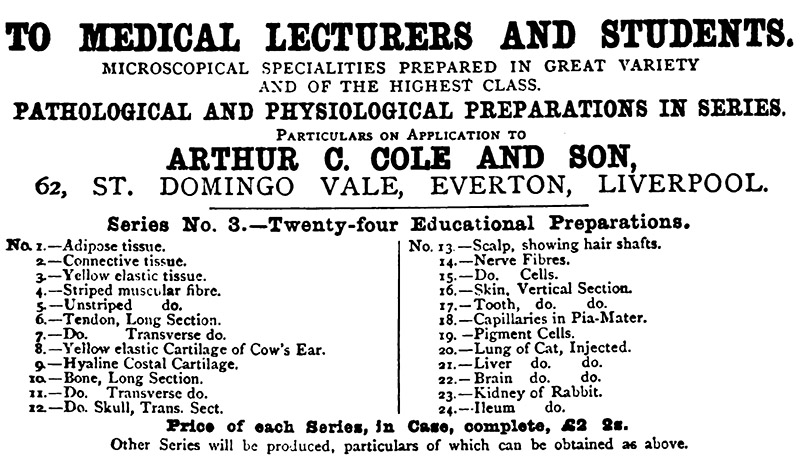
Figure 14.
March, 1877 advertisement, from “The British Medical Journal”. Similar advertisements appeared in that publication through May, 1877.

Figure 15.
Arthur and Martin Cole moved from Liverpool back to London during mid-/late-1877, as evidenced by this December 1, 1877 advertisement from “The Doctor”.

Figure 16.
1880 and 1881 advertisements from William Shrubsole (1837-1927) and Cole and Son, announcing that the Coles were producing microscope slides of mineralized diatoms that Shrubsole had discovered in a stratum of “London Clay”. From “Nature” and “Hardwicke’s Science-Gossip”.
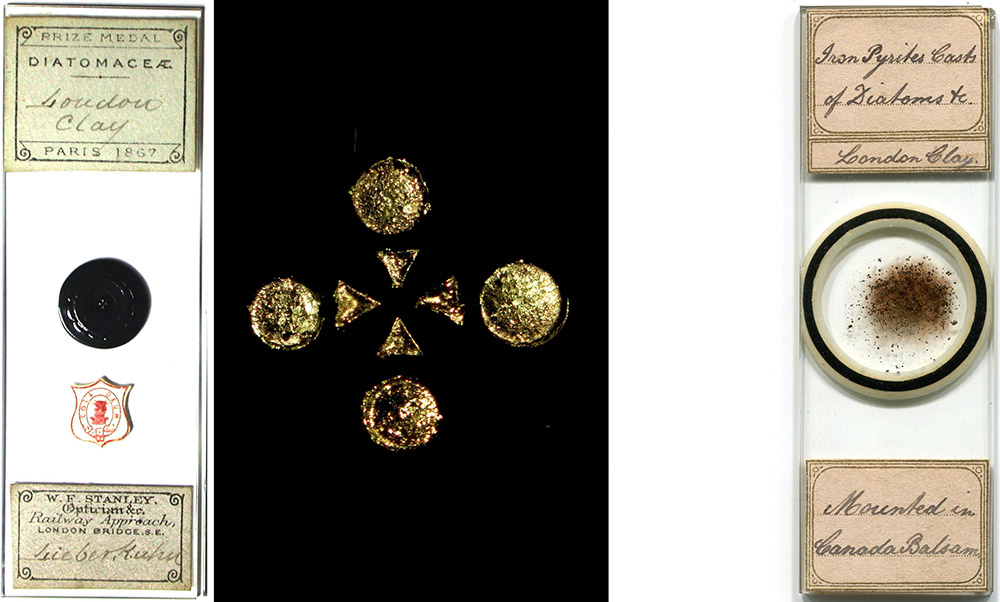
Figure 17.
Circa 1880 slides of pyritized diatoms from London clay. (Left) Preparation of arranged diatoms by Arthur C. Cole (and distributed by W.F. Stanley). (Right) A strew of diatoms by an unknown mounter. In 1880, W.H. Shrubsole warned that people other than Cole were selling slides of mineralized London clay diatoms (see Figure 16 and text).

Figure 18.
The first two pages of issue 1 of Arthur Cole’s “Studies in Microscopical Science”, May, 1883. The whole 52 issues of Volume 1 were republished as a bound book in June, 1884.

Figure 19.
Volume 2 of Arthur Cole’s “Studies in Microscopical Science” was issued in May, 1884, and accompanied by a supplementary essay in Ernest Ady’s “Methods of Microscopical Research”. The second page included a list of the slides that Cole issued in his Volume 1.

Figure 20.
1890 advertisement from Martin Cole, promoting his microscope slides and his classes in histology, pathology, and slide preparation. From “Hardwicke’s Science-Gossip”.
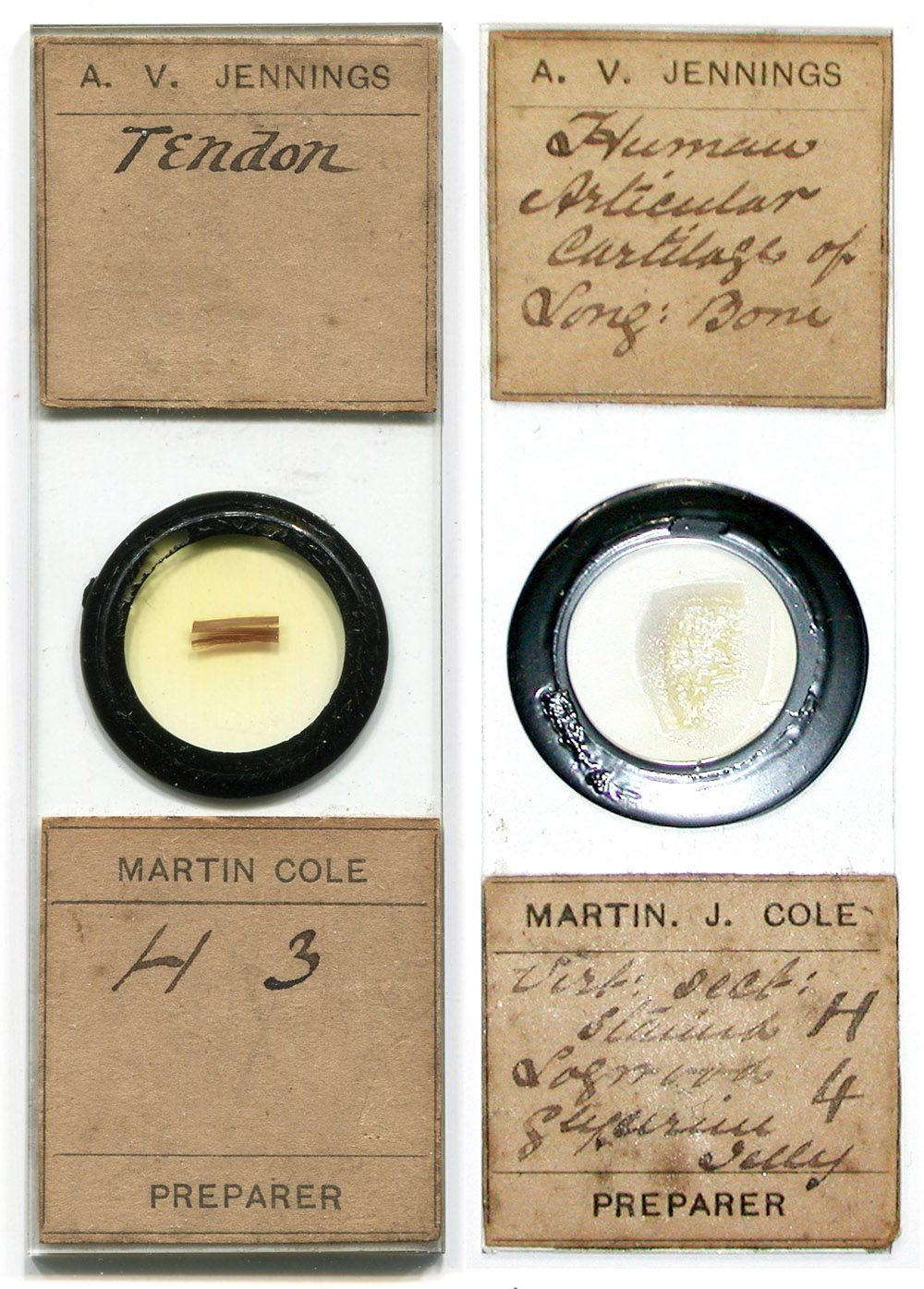
Figure 21.
Uncommon microscope slides by Martin Cole that also carry labels from Alfred V. Jennings. Images from the collections of the author and of Howard Lynk.

Figure 22.
1889 advertisement by Arthur Cole. Note that he was a distributor of Joseph Sinel’s microscope slides. From “Hardwicke’s Science-Gossip”.
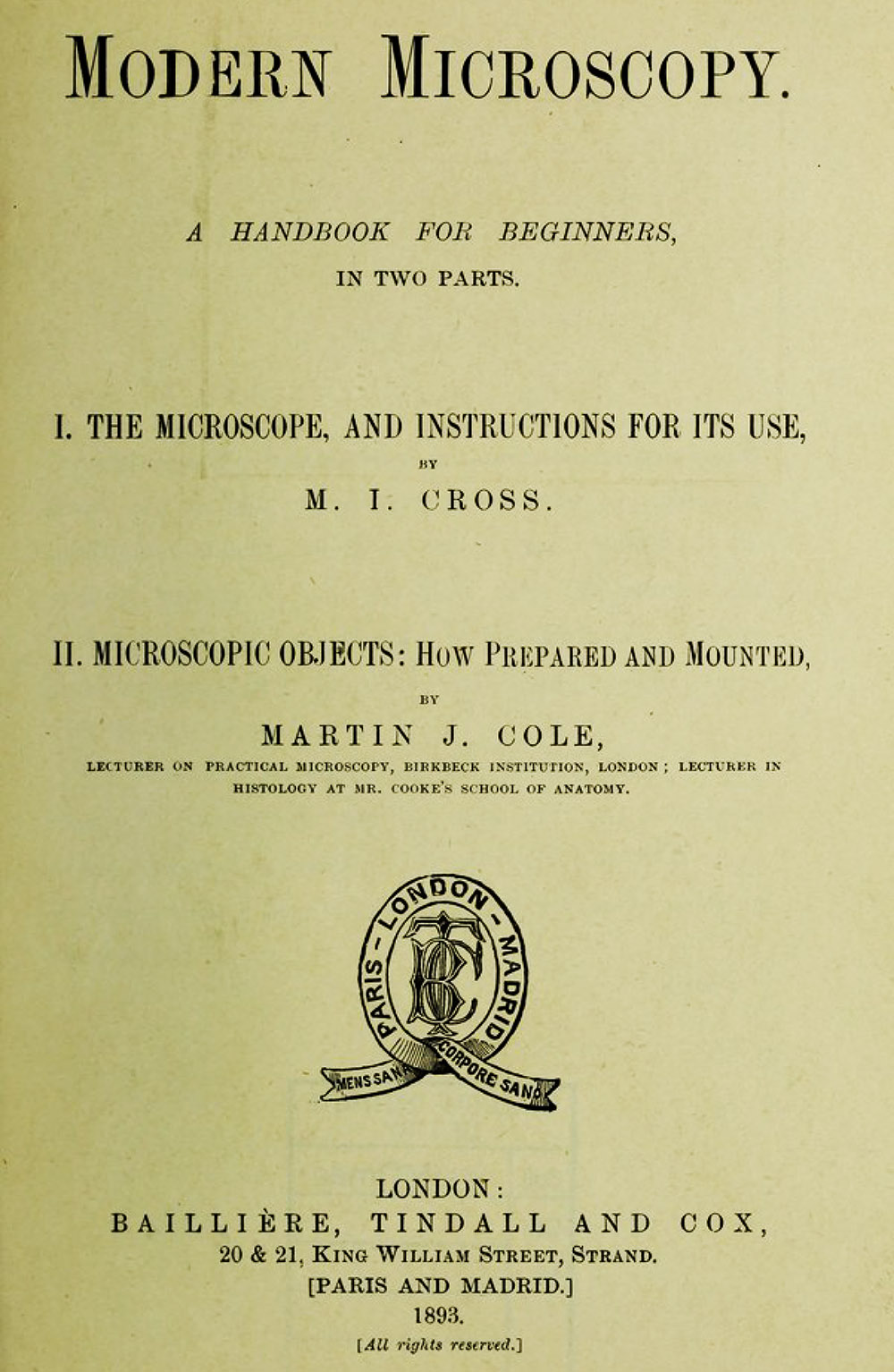
Figure 23.
Title page of the 1893, first edition of Cross & Cole’s “Modern Microscopy”.
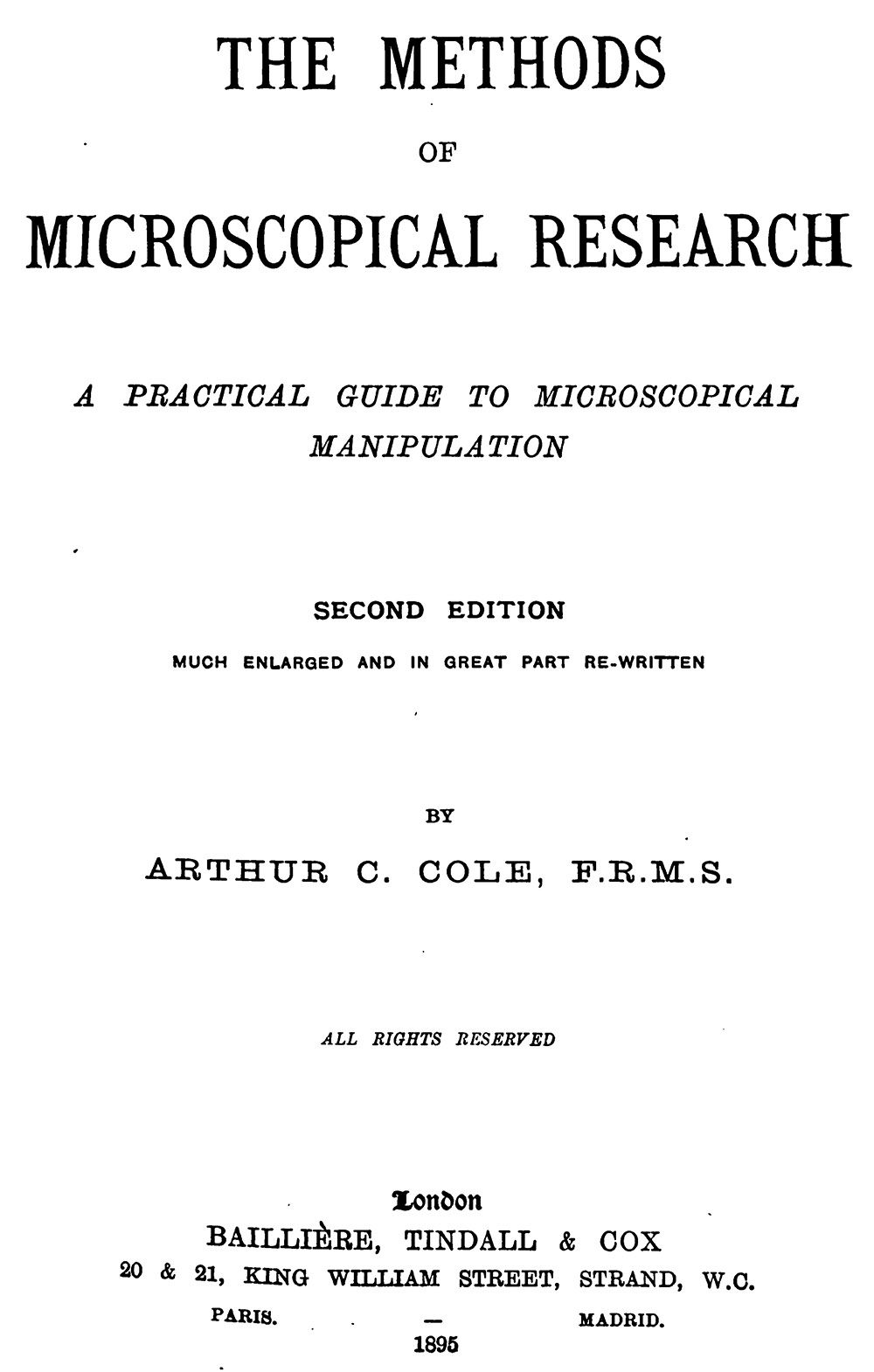
Figure 24.
Title page of Arthur Cole’s “Methods of Microscopical Research, Second Edition”. It was largely a re-publication of his earlier, 1880s essays on the microscope.

Figure 25.
1896 advertisement by Martin Cole, from “The Journal of Malacology”.
Acknowledgement
Many thanks to Howard Lynk for his continued assistance with this project, and for generously contributing images of slides and other items from his collection.
Resources
Ady, John Ernest (1883) The Methods of Microscopical Research, June 16
Astbury, Amy (1911) Nature study and the microscope, Country Home, Vol. 7, pages 152-156
Bracegirdle, Brian (1998) Microscopical Mounts and Mounters, Quekett Microscopical Club, London, pages 23-25, 122, 124, 190, 202, 210, and Plates 9-P through S, 10-A through S, 43-L, 49-B, and 53-D. Additional slides that appear to bear Martin Cole’s handwriting are shown in Plates 3-O, 4-E, 4-G. 13-P, and 43-A
British Medical Journal (1875) Microscopic slides, page 558
British Medical Journal (1877) Advertisement from Arthur C. Cole and Son, May issue
Catalogue of the British Section: Paris Universal Exhibition (1867) “Cole, Arthur Chas., 298 Upper Parliament street, Liverpool, Microscopic objects”
Cole, Arthur C. (1883) Studies in Microscopical Science, Vol. 1, Bailliere, Tindall, and Cox, London
Cole, Arthur C. (1884) Studies in Microscopical Science, Vol. 2, Bailliere, Tindall, and Cox, London
Cole, Arthur C. (1895) The Methods of Microscopical Research: A Practical Guide to a Microscopical Manipulation, Second edition, Bailliere, Tindall, and Cox, London
Cole, Martin J. (1926) The preparation and mounting of Heparics, Mycetozoa, etc., Watson’s Microscope Record, May issue, pages 6-11
Cross, M.I. and Martin J. Cole (1893) Modern Microscopy, Bailliere, Tindall and Cox, London
Cross, M.I. and Martin J. Cole (1895) Modern Microscopy, Second Edition, Bailliere, Tindall and Cox, London
De Wolf, H., F.A.S. Sterrenburg, and S. Gill (2004) The Natural History Museum diatom collection, The Amateur Diatomist, Vol. 2, pages 8-41
The Doctor (1877) Advertisement from Arthur C. Cole and Son, December 1 issue (notes move to London)
England census and other records, accessed through ancestry.com
English Mechanics and the World of Science (1880) Report of the April 2 meeting of the Liverpool Microscopical Society, “Mr. A.C. Cole, of London, an Honorary Member”, Vol. 31, page 107
Gill, Steve (2023) Quekett Microscopical Club President’s Address, https://www.quekett.org/wp-content/uploads/2023/06/Presidential-Address-May-2023.pdf
Green & Co.'s Directory for Liverpool and Birkenhead (1870) “Cole, Arthur, 66, St Domingo vale”, A. Green, London, page 41
Griffith, Alfred W. (1884) On the collection and preparation of the Diatomaceae, Journal of Microscopy and Natural Science, pages 138-146
Hardwicke's Science-Gossip (1873) Exchange offer from A.C. Cole, Vol. 8, page 24
Hardwicke's Science-Gossip (1881) Advertisements from W.H. Shrubsole, Vol. 17, January issue, page x
Hardwicke's Science-Gossip (1882) Studies in Microscopical Science, Vol. 18, page 138
Hardwicke's Science-Gossip (1884) Cole’s Microscopical Studies, Vol. 20, page 236
Hardwicke's Science-Gossip (1889) Mr. A.C. Cole’s new slides, Vol. 25, page 184
Hardwicke's Science-Gossip (1890) Advertisements from M.J. Cole, Vol. 26, multiple issues
The Illustrated London News (1885) Advertisement from Arthur C. Cole, September 8 issue, page 303
The Innkeeper and Traveller (1861) “Insolvents: Cole, Arthur Charles, teacher of music and organist, East Greenwich”, February issue, page 67
The Journal of Malacology (1896) Advertisement from M.J. Cole, Vol. 5, page iv
Journal of the Quekett Microscopical Club (1870) “The following donations to the Club were announced … 12 Slides of diatoms, Mr. A.C. Cole, Liverpool” Vol. 2, page 150
Journal of the Quekett Microscopical Club (1884) Members list
Journal of the Quekett Microscopical Club (1887) Members list
Journal of the Royal Microscopical Society (1879) “Fellows … 1879 Cole, Arthur Charles. St. Domingo House, Oxford-gardens, Notting-hill, W.”
Journal of the Royal Microscopical Society (1879) Minutes of the May 14 meeting, pages 488-492
The Lancet (1875) Microscopical preparations, page 826
The Lancet (1876) Advertisement from Arthur C. Cole & Son, multiple issues
Liverpool Electoral Register (1865) “Cole, Arthur, Great Newton street”, accessed through ancestry.com
London Gazette (1881) Notice of the dissolution of the partnership between A.C. Cole and M.J. Cole, January 7 issue, page 87
The Midland Naturalist (1880) Report of the November 15 meeting of the Birmingham Natural History and Microscopical Society, “On the Mineralised Diatoms found by Mr. W. H. Shrubsole, F.G.S., in the London Clay," illustrated by specimens, including a beautifully arranged slide of selected diatoms prepared by Messrs. A. C. Cole and Son”, Vol. 3, page 299
The Monthly Microscopical Journal (1871) Minutes of the Microscopical Society of Liverpool March 3 meeting, Vol. 6, page 114
Nature (1880) Advertisement from W.H. Shrubsole, April 8 issue
Official Catalogue of the British Section of the Paris Exhibition (1878) “Cole, Arthur C, & Son ; Preparers of Microscopical Specimens; St. Domingo House, Oxford Gardens, Notting Hill, London”, page 46
Probate of the Will of John James Cole (1867) “Letters of Administration of the Personal estate and effects of John James Cole late of Victoria-terrace Barrow-hill-road St. John’s Wood in the Count of Middlesex Widower deceased who died 26 July 1867 at Victoria-terrace aforesaid were granted at the Principal Registry to Arthur Charles Cole of 66 St. Domino-vale Everton Liverpool in the County of Lancaster Book-keeper the Son and only Next of Kin of the said Deceased he having been first sworn.” Accessed through ancestry.com
Shrubsole, W.H. (1880) Diatoms in London clay, Nature, Vol. 21, page 538
Spence, D.D. (1948) The Postal Microscopical Society, The Microscope, Vol. 7, pages 308-310 (includes a photograph of A.C. Cole)
Watson’s Microscope Record (1926) Enamel for ringing slides, December issue, page 31
Watson’s Microscope Record (1928) Obituary, Martin James Cole, May issue, page 19
Wells, H.G. (1934) Experiment in Autobiography
























